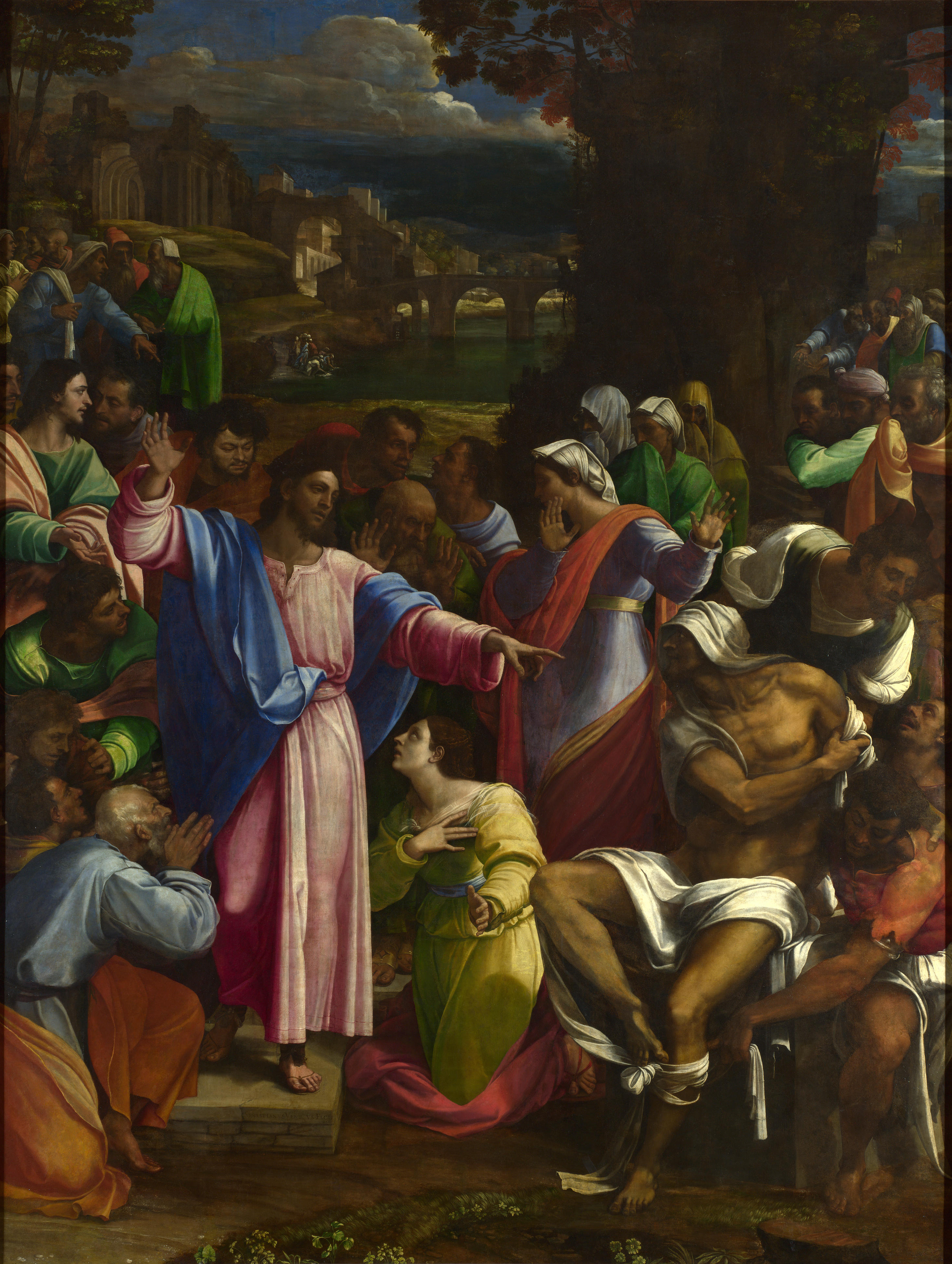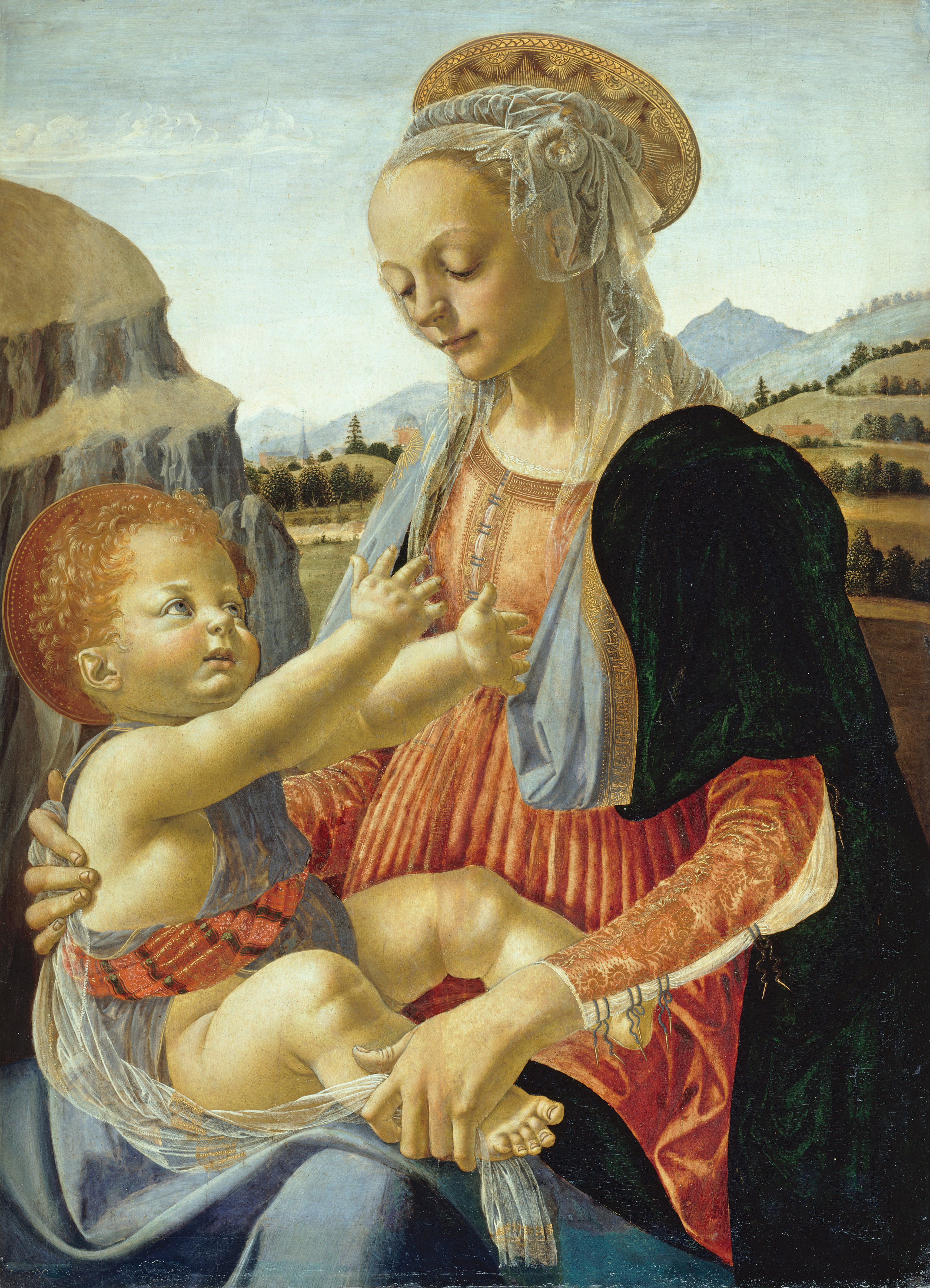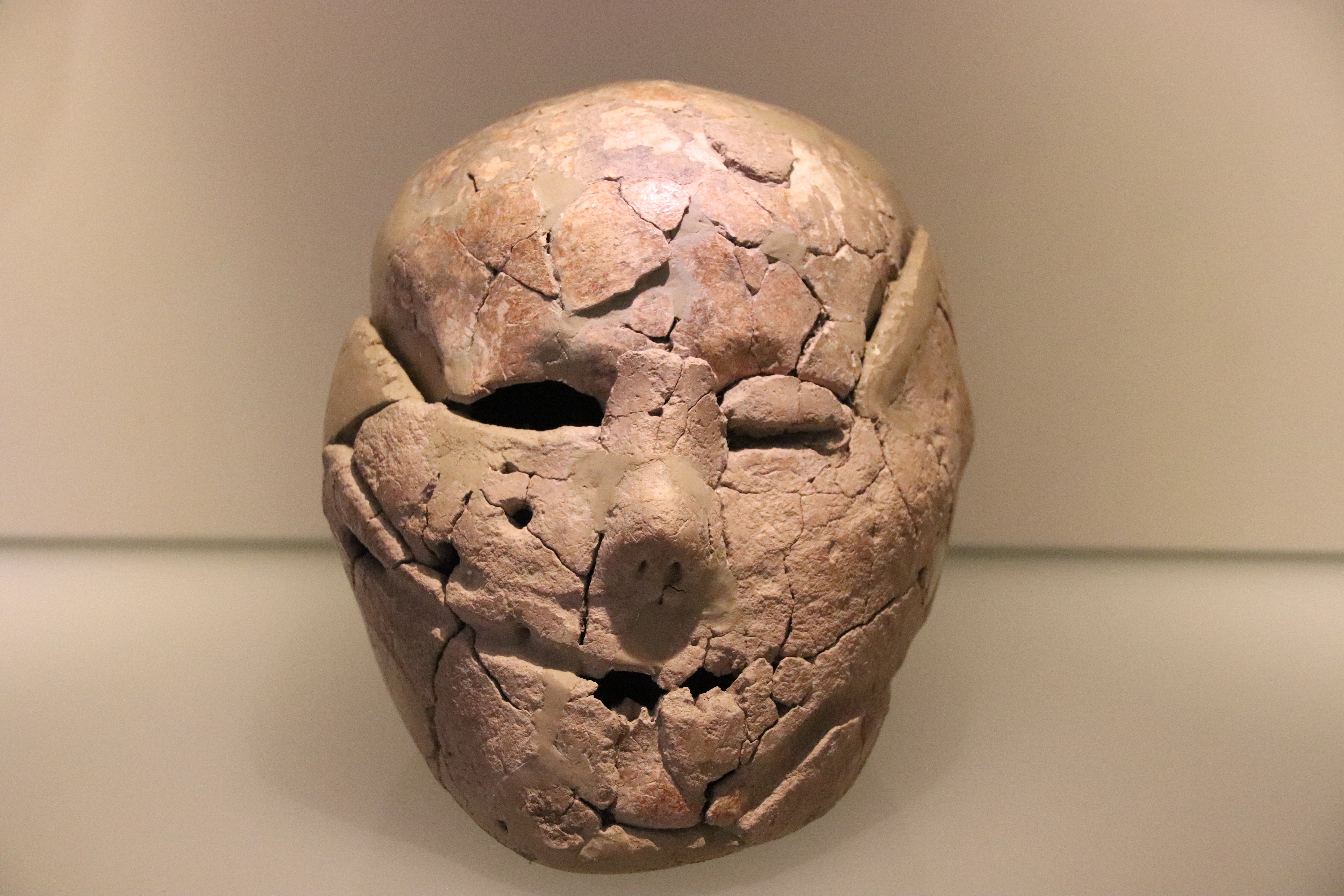|
Portrait Of Lorenzo Di Credi
The ''Portrait of Lorenzo di Credi'' is a painting by the Italian Renaissance artist Perugino, dating to around 1504 and housed in the National Gallery of Art, Washington, DC, United States. Description Before the painting was transferred to canvas, the wooden support had the inscription "Lorenzo di Credi, pittore più eccellente, 1488, età 32 anni, 8 mesi", perhaps added in the 16th century. For centuries, this was thought to be a self-portrait signature: however, starting from the 20th centuries the work was attributed, due to styilistical considerations, to Pietro Perugino (in particular, for the similitarities to the ''Portrait of Francesco delle Opere'' at the Uffizi), who had studied with Lorenzo in Verrocchio's workshop. The painter is portrayed from three-quarters, with a rocky and hilly landscape in the background. He wears a black berret and a blouse of the same color, the collar of a white shirt barely visible at the neck. The melancholic expression, as well as the b ... [...More Info...] [...Related Items...] OR: [Wikipedia] [Google] [Baidu] |
Lorenzo Di Credi
Lorenzo di Credi (1456/59 – January 12, 1537) was an Italian Renaissance painter and sculptor best known for his paintings of religious subjects. He is most famous for having worked in the studio of Andrea del Verrocchio at the same time as the young Leonardo da Vinci. Life Lorenzo was born in Florence in 1456 or 1459 to a goldsmith named Andrea d' Oderigo. He was apprenticed to Andrea del Verrocchio, probably in the mid-1470s. He eventually became Verrocchio's primary assistant and inherited his workshop on Verrocchio's death in 1488. On Verrocchio's behalf he completed the famous ''Madonna di Piazza'' for the cathedral of Pistoia, commissioned to Verrocchio in 1475 but executed by Lorenzo between 1485 and 1491. Lorenzo's earliest independent works include an ''Annunciation'' in the Uffizi, two panels of the ''Madonna and Child'' at the Galleria Sabauda in Turin, another at the National Gallery in London and ''Adoration of the Child'' at the Pinacoteca Querini Stampa ... [...More Info...] [...Related Items...] OR: [Wikipedia] [Google] [Baidu] |
Pietro Perugino
Pietro Perugino (, ; – 1523), born Pietro Vannucci, was an Italian Renaissance painter of the Umbrian school, who developed some of the qualities that found classic expression in the High Renaissance. Raphael was his most famous pupil. Early years He was born Pietro Vannucci in Città della Pieve, Umbria, the son of Cristoforo Maria Vannucci. His nickname characterizes him as from Perugia, the chief city of Umbria. Scholars continue to dispute the socioeconomic status of the Vannucci family. While certain academics maintain that Vannucci worked his way out of poverty, others argue that his family was among the wealthiest in the town. His exact date of birth is not known, but based on his age at death that was mentioned by Vasari and Giovanni Santi, it is believed that he was born between 1446 and 1452. Pietro most likely began studying painting in local workshops in Perugia such as those of Bartolomeo Caporali or Fiorenzo di Lorenzo. The date of the first Florentine sojou ... [...More Info...] [...Related Items...] OR: [Wikipedia] [Google] [Baidu] |
Transfer Of Panel Paintings
The practice of conserving an unstable panel painting, painting on panel by transferring it from its original decayed, worm-eaten, cracked, or distorted wood support to canvas or a new panel has been practised since the 18th century. It has now been largely superseded by improved methods of wood conservation. The practice evolved in Naples and Cremona in 1711–1725 and reached France by the middle of the 18th century. It was especially widely practiced in the second half of the 19th century. Similar techniques are used to transfer frescos. Oil paintings on canvas often receive lining of paintings, additional support or are transferred to a new backing. Methods The process is described by Henry Mogford in his '' Handbook for the Preservation of Pictures''. Smooth sheets of paper were pasted over the painted surface of the panel, and a layer of muslin over that. The panel was then fixed, face down, to a table, and the wood planed away from the back until it was "as thin as a pla ... [...More Info...] [...Related Items...] OR: [Wikipedia] [Google] [Baidu] |
National Gallery Of Art
The National Gallery of Art, and its attached Sculpture Garden, is a national art museum in Washington, D.C., United States, located on the National Mall, between 3rd and 9th Streets, at Constitution Avenue NW. Open to the public and free of charge, the museum was privately established in 1937 for the American people by a joint resolution of the United States Congress. Andrew W. Mellon donated a substantial art collection and funds for construction. The core collection includes major works of art donated by Paul Mellon, Ailsa Mellon Bruce, Lessing J. Rosenwald, Samuel Henry Kress, Rush Harrison Kress, Peter Arrell Browne Widener, Joseph E. Widener, and Chester Dale. The Gallery's collection of paintings, drawings, prints, photographs, sculpture, medals, and decorative arts traces the development of Western Art from the Middle Ages to the present, including the only painting by Leonardo da Vinci in the Americas and the largest mobile created by Alexander Calder. The Gall ... [...More Info...] [...Related Items...] OR: [Wikipedia] [Google] [Baidu] |
Perugino
Pietro Perugino (, ; – 1523), born Pietro Vannucci, was an Italian Renaissance painter of the Umbrian school, who developed some of the qualities that found classic expression in the High Renaissance. Raphael was his most famous pupil. Early years He was born Pietro Vannucci in Città della Pieve, Umbria, the son of Cristoforo Maria Vannucci. His nickname characterizes him as from Perugia, the chief city of Umbria. Scholars continue to dispute the socioeconomic status of the Vannucci family. While certain academics maintain that Vannucci worked his way out of poverty, others argue that his family was among the wealthiest in the town. His exact date of birth is not known, but based on his age at death that was mentioned by Vasari and Giovanni Santi, it is believed that he was born between 1446 and 1452. Pietro most likely began studying painting in local workshops in Perugia such as those of Bartolomeo Caporali or Fiorenzo di Lorenzo. The date of the first Florentine ... [...More Info...] [...Related Items...] OR: [Wikipedia] [Google] [Baidu] |
Washington, DC
) , image_skyline = , image_caption = Clockwise from top left: the Washington Monument and Lincoln Memorial on the National Mall, United States Capitol, Logan Circle, Jefferson Memorial, White House, Adams Morgan, National Cathedral , image_flag = Flag of the District of Columbia.svg , image_seal = Seal of the District of Columbia.svg , nickname = D.C., The District , image_map = , map_caption = Interactive map of Washington, D.C. , coordinates = , subdivision_type = Country , subdivision_name = , established_title = Residence Act , established_date = 1790 , named_for = George Washington, Christopher Columbus , established_title1 = Organized , established_date1 = 1801 , established_title2 = Consolidated , established_date2 = 1871 , established_title3 = Home Rule Act ... [...More Info...] [...Related Items...] OR: [Wikipedia] [Google] [Baidu] |
Portrait Of Francesco Delle Opere
The ''Portrait of Francesco delle Opere'' is a painting by the Italian Renaissance artist Perugino, dating to 1494 and housed in the Uffizi Gallery, Florence. History The first mention of the painting is in the inventory of Cardinal Leopoldo de' Medici's artworks, as a work of "Second Manner Raphael". In the 19th century it was attributed to Perugino and Jacopo Francia, and then again to Perugino Pietro Perugino (, ; – 1523), born Pietro Vannucci, was an Italian Renaissance painter of the Umbrian school, who developed some of the qualities that found classic expression in the High Renaissance. Raphael was his most famous pupil. Ear ... by Antonio Ramirez de Montalvo, who discovered an inscription in the rear. This reads: "1494 DI LVGLIO PIETRO PERVGINO PINSE FRANC SC DEL LOPRE PEYNAGA". It was long considered a self-portrait, and from 1883 it was therefore exhibited in the gallery of self-portraits in the Vasarian Corridor. In 1881 the subject was finally iden ... [...More Info...] [...Related Items...] OR: [Wikipedia] [Google] [Baidu] |
Uffizi
The Uffizi Gallery (; it, Galleria degli Uffizi, italic=no, ) is a prominent art museum located adjacent to the Piazza della Signoria in the Historic Centre of Florence in the region of Tuscany, Italy. One of the most important Italian museums and the most visited, it is also one of the largest and best known in the world and holds a collection of priceless works, particularly from the period of the Italian Renaissance painting, Italian Renaissance. After the ruling House of Medici died out, their art collections were given to the city of Florence under the famous ''Patto di famiglia'' negotiated by Anna Maria Luisa de' Medici, Anna Maria Luisa, the last Medici heiress. The Uffizi is one of the first modern museums. The gallery had been open to visitors by request since the sixteenth century, and in 1765 it was officially opened to the public, formally becoming a museum in 1865. History The building of the Uffizi complex was begun by Giorgio Vasari in 1560 for Cosimo I de' M ... [...More Info...] [...Related Items...] OR: [Wikipedia] [Google] [Baidu] |
Verrocchio
Andrea del Verrocchio (, , ; – 1488), born Andrea di Michele di Francesco de' Cioni, was a sculptor, Italian painter and goldsmith who was a master of an important workshop in Florence. He apparently became known as ''Verrocchio'' after the surname of his master, a goldsmith. Few paintings are attributed to him with certainty, but a number of important painters were trained at his workshop. His pupils included Leonardo da Vinci, Pietro Perugino and Lorenzo di Credi. His greatest importance was as a sculptor and his last work, the Equestrian statue of Bartolomeo Colleoni in Venice, is generally accepted as a masterpiece. Life Verrocchio was born in Florence in around 1435. His father, Michele di Francesco Cioni, initially worked as a tile and brick maker, then later as a tax collector. Verrocchio never married, and had to provide financial support for some members of his family. He was at first apprenticed to a goldsmith. It has been suggested that he was later apprenticed to Do ... [...More Info...] [...Related Items...] OR: [Wikipedia] [Google] [Baidu] |
Portrait Of Perugino
The ''Portrait of Perugino'' is a portrait of the Italian Renaissance artist Perugino attributed to his pupil Raphael or to Lorenzo di Credi. It was produced around 1504 and is now in the Uffizi gallery, Florence. History The painting is known to have been in the Florentine Galleries since as early as 1704, when it was identified as a portrait of Martin Luther and was attributed to Hans Holbein the Younger. In an 1825 comment to Giorgio Vasari's ''Vite'', it was listed as a ''Portrait of Verrocchio'' by Lorenzo di Credi. Adolfo Venturi in 1922 attributed it to Perugino himself, while the attribution to Raphael appeared in the 1930s. The identification with Perugino is today ascertained thanks to the evident similarities with the self-portrait in the Collegio del Cambio. Copies of the painting exist in Vienna, London, Bergamo, Rome and in the Gallerie dell'Accademia in Venice. See also *''Portrait of Lorenzo di Credi'' References {{DEFAULTSORT:Portrait Of Perugino (Rapha ... [...More Info...] [...Related Items...] OR: [Wikipedia] [Google] [Baidu] |
Paintings By Pietro Perugino
Painting is the practice of applying paint, pigment, color or other medium to a solid surface (called the "matrix" or "support"). The medium is commonly applied to the base with a brush, but other implements, such as knives, sponges, and airbrushes, can be used. In art, the term ''painting ''describes both the act and the result of the action (the final work is called "a painting"). The support for paintings includes such surfaces as walls, paper, canvas, wood, glass, lacquer, pottery, leaf, copper and concrete, and the painting may incorporate multiple other materials, including sand, clay, paper, plaster, gold leaf, and even whole objects. Painting is an important form in the visual arts, bringing in elements such as drawing, composition, gesture (as in gestural painting), narration (as in narrative art), and abstraction (as in abstract art). Paintings can be naturalistic and representational (as in still life and landscape painting), photographic, abstract ... [...More Info...] [...Related Items...] OR: [Wikipedia] [Google] [Baidu] |
Portraits By Italian Artists
A portrait is a painting, photograph, sculpture, or other artistic representation of a person, in which the face and its expressions are predominant. The intent is to display the likeness, personality, and even the mood of the person. For this reason, in photography a portrait is generally not a snapshot, but a composed image of a person in a still position. A portrait often shows a person looking directly at the painter or photographer, in order to most successfully engage the subject with the viewer. History Prehistorical portraiture Plastered human skulls were reconstructed human skulls that were made in the ancient Levant between 9000 and 6000 BC in the Pre-Pottery Neolithic B period. They represent some of the oldest forms of art in the Middle East and demonstrate that the prehistoric population took great care in burying their ancestors below their homes. The skulls denote some of the earliest sculptural examples of portraiture in the history of art. Historical ... [...More Info...] [...Related Items...] OR: [Wikipedia] [Google] [Baidu] |

.jpg)




